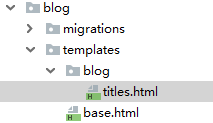簡單的部落格系統(四)Django請求HTML頁面檢視資訊--基於函式的檢視
阿新 • • 發佈:2019-07-21
1. 編寫用於查詢資料的功能函式
應用目錄 下的
views.py檔案通常用於儲存響應各種請求的函式或類
from django.shortcuts import render from .models import BlogArticles # Create your views here. def blog_title(request): # request 負責響應所接收到的請求 # 查詢得到所有 BlogArticles 表中的所有例項資料 blogs = BlogArticles.objects.all() """ render() 作用是將資料渲染到指定模板上 "blog/titles.html" 指定渲染到哪個頁面,頁面路徑為應用目錄下的templates目錄 {"blogs": blogs} 為傳給頁面的資料 """ return render(request, "blog/titles.html", {"blogs": blogs})
2. 在應用目錄下建立相關html頁面檔案
- 檔案目錄結構如下:

- 編寫相關頁面程式碼
<!-- base.html公共模板頁面 --> <!DOCTYPE html> <html lang="zh-CN"> <head> <meta charset="utf-8"> <meta http-equiv="X-UA-Compatible" content="IE=edge"> <meta name="viewport" content="width=device-width, initial-scale=1"> <title>{% block title %}{% endblock %}</title> <!-- 表示裡面的內容被 title block 代替 --> <!-- Bootstrap --> <link href="https://cdn.jsdelivr.net/npm/[email protected]/dist/css/bootstrap.min.css" rel="stylesheet"> <!--[if lt IE 9]> <script src="https://cdn.jsdelivr.net/npm/[email protected]/dist/html5shiv.min.js"></script> <script src="https://cdn.jsdelivr.net/npm/[email protected]/dest/respond.min.js"></script> <![endif]--> </head> <body> <div class="container"> {% block content %} <!-- 表示頁面的內容被 content block 代替 --> {% endblock %} </div> <script src="https://cdn.jsdelivr.net/npm/[email protected]/dist/jquery.min.js"></script> <script src="https://cdn.jsdelivr.net/npm/[email protected]/dist/js/bootstrap.min.js"></script> </body> </html> <!-- titles.html --> {% extends "base.html" %} <!-- 繼承 base.html 模板頁 --> {% block title %} 部落格標題 {% endblock %} {% block content %} <div class="row text-center vertical-middles-sm"> <h1>我的部落格</h1> </div> <div class="row"> <div class="col-xs-12 col-md-8"> <ul> <!-- 迴圈遍歷 blogs 裡的物件 --> {% for blog in blogs %} <li>{{ blog.title }}</li> {% endfor %} </ul> </div> </div> {% endblock %}
3. 配置URL
- 編寫 專案目錄 下的
urls.py檔案
from django.contrib import admin
from django.urls import path, include
urlpatterns = [
path('admin/', admin.site.urls),
path("blog/", include('blog.urls')), # 通過這裡將blog/請求轉向blog應用的urls.py,即./blog/urls.py檔案
- 編寫 應用目錄 下的
urls.py檔案
from django.urls import path from . import views """ 第一個引數為空,表示訪問根,因為該檔案在blog應用中,則要為blog/ views.blog_title 表示響應該請求的函式 """ urlpatterns = [ path('', views.blog_title), ]
- 啟動專案訪問:
http://127.0.0.1:8000/blog/即可看到結果
4. 給url傳引數
- 修改
titles.html檔案給文章標題新增連結
<!-- 迴圈遍歷 blogs 裡的物件 -->
{% for blog in blogs %}
<li><a href="{{ blog.id }}">{{ blog.title }}</a></li>
{% endfor %}
- 為該請求編寫對應的函式(
./blog/views.py)
def blog_article(request, article_id): # 該請求傳入 article_id 引數
article = BlogArticles.objects.get(id=article_id)
pub = article.publish
return render(request, "blog/content.html",{"article":article, "publish":pub})
- 編寫顯示檔案內容的html頁面(templates/blog/content.html)
{% extends "base.html" %} <!-- 繼承 base.html 模板頁 -->
{% block title %}
部落格標題
{% endblock %}
{% block content %}
<div class="row text-center vertical-middles-sm">
<h1>{{ article.title }}</h1>
</div>
<div class="row">
<div class="col-xs-12 col-md-8 col-md-offset-2">
<p class="text-center">
<span>{{ article.author.username }}</span>
<span style="margin-left: 20px;">{{ publish }}</span>
</p>
<div>{{ article.body }}</div>
</div>
</div>
{% endblock %}
- 增加請求所對應的url(./blog/urls.py)
urlpatterns = [
path('', views.blog_title),
path('<int:article_id>/', views.blog_article),
]
URL配置和查詢
當用戶通過瀏覽器請求某個URL時,Django會根據請求路徑依次在URLConf中查詢,並將第一個符合條件的對映關係作為查詢結果。
例如,訪問 http://localhost:8000/blog/1,其請求過程如下:
localhost:8000:主域名部分,不進行查詢/blog/:首先在專案目錄/urls.py中查詢,遇到符合條件的URL對映(path('blog/', include('blog.urls')),),根據此對映中的描述,到blog.urls(./blog/urls.py)中查詢/1:在./blog/urls.py中有URL(path('<int:article_id>/', views.blog_article))配置,請求路徑正好符合,從而確定最終訪問的檢視函式views.blog_
